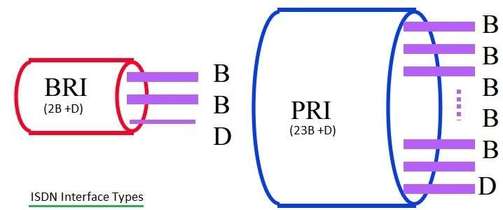Primary rate interface (PRI) is an older bit of technology for connecting digital and analog telecommunications systems and handling multiple data transfers on a single line. It first came about in the 1980s and swiftly became a standard for offices. Like session border controllers, it’s a physical piece of hardware added to your communications setup to enhance functionality.
What Does Primary Rate Interface (PRI) Do?
Like PSTN lines, PRIs work on copper wiring. Two pairs of copper wires link the network to the customer, providing digital access to the PSTN (like DID does). However, PRI technology is closer to VoIP than the PSTN in that a single “line” can actually carry multiple conversations at once. Quite specifically, it has 23 channels, meaning 23 different people can talk, instant message, or video call at the same time from the same piece of equipment.
Technical Specs
PRI has 1 64 kbps D channel and 23 64 kbps B channels. Some have 30 of the latter, but 23 is most common. This is an upgrade from basic rate interface (BRI), more often used in residential or small business settings. The BRI setup has two 64 kbps B channels and one 16kbps D channel.
PRIs have more bandwidth to handle the greater number of channels. The D channel carries control and signaling information, while the B channels carry the literal data from voice, chat, and video services—all the fun WebRTC features we know and love!

In plainer English, PRI was an update to the single phone lines of the PSTN to allow more callers on a single line. You’re likely reading this and thinking, “Well, isn’t that what VoIP does?” and you’re right! Consider PRI the first upgrade to the PSTN and VoIP, particularly hosted VoIP, the next upgrade. We understand this can get confusing, especially if you’re unsure which telecommunications setup you currently have and which would work best for you moving forward.
Do You Need PRI With VoIP?
That depends! With hosted VoIP like OnSIP, not at all. Feel free to forget this 40-year-old technology. If you have on-premises PBX or are still on the analog phone system, then you do need something to connect between digital and analog communications. PRIs are one piece of hardware that can do this. It’s why they became a fairly popular standard in offices for some time. Unfortunately, they’re locked in at 23 channels per additional PRI device. So they’re not the most flexible.
Usually, lack of flexibility is a trade-off for smaller businesses compared to larger enterprises. For once, neither group benefits. Smaller businesses might want to add one or two lines at a time as they grow, so PRIs are a bit too big. Large enterprises adding new offices or on a hiring spree are likely to need more than just 23 new lines at a time so would have to buy and install several PRIs to catch up. To sum it up, anyone with landlines or on-premises PBX systems are honestly better off choosing SIP trunking over PRI hardware for its flexibility. They do the same job, after all.
If you’re in the market for scalable digital communications, your best bet is hosted VoIP. It’s steadily grown in popularity over the years and especially at the start of the 2020s. With hosted VoIP, you don’t need any additional hardware to add channels or video capabilities. Cheers to skipping upfront costs and messy installs!

